By Chris Glyde
When someone calls me for guitar lessons, about 75% of the time the caller is a beginner, and all of those 75% of beginners have the same frustration. They can’t play chords! Then they list all of the possible reasons why they can’t seem to figure it out. They claim to be just not very musical, or too old, or with hands that are too big, or that they have no coordination. The list goes on and on. But in reality, none of these things were the problem.
The problem was this phrase: “Try to keep your fingers as close to the fretboard as possible.”
I would assume that you’ve heard this statement before, but if not, realize that it’s a very common phrase. And even if you haven’t heard it before, you’re probably already operating from the basic idea underlying this phrase. The idea makes sense because the closer your fingers are to the fretboard, the more likely it is that you’ll have no problem getting to the right frets.
The reality, though, is that I hate this phrase because it makes the distance between your fingers and the fretboard subjective. It says to keep them as close as you can keep them. It doesn’t explain at all whether you’re close enough, or how you could get closer. If your fingers are two inches away, for example, and that’s as close as you’ve ever been able to get them, you may just state that this is as close as you can get them.
So, today we are going to replace this idea. From now, on you’re not going to try to keep your fingers as close as possible to the fretboard. From now on, you’re going to
SHIFT, NOT LIFT, YOUR FINGERS.
There is no need for you to lift your fingers away from the fretboard at all. There is a video below that accompanies this article. Please watch this quick video for a demonstration. Again, your focus from now on is to shift your fingers, not lift your fingers.
Let’s go through a step-by-step process to help you work on this technique. It’s not too difficult, but I suggest that you read the guidelines and perform each step individually as we go through them. And when you’re finished going through the steps, please read over all the steps again. If you don’t, you will probably miss important information.
1) Form any chord you like, if you’re unsure which one to form at this point in time, start with the G Major Chord. Here’s a picture of the G Major Chord (below).

2) Press down on the strings, and let it ring out for a couple of seconds.
3) Relax your fingers. This does not mean you take them off the strings. Release the pressure from your fingers, but the fingers themselves should still remain in contact with the strings.
4) Now, without lifting your fingers away from the fretboard, shift your fingers into position to play the next chord. Let’s just use the C Major Chord.
5) Repeat this process repeatedly until you feel comfortable with the chord change.

Tips:
1) Getting a handle on the sensation of “Shift Not Lift” will take some time. My advice to you would be to make the transition take four seconds so that your brain has enough time not only to process the movement, but to figure out how to transition between each type of chord.
About The Author
Chris Glyde is a dedicated guitar player from Rochester, New York. Check out his website here. Rochester Guitar Lessons

